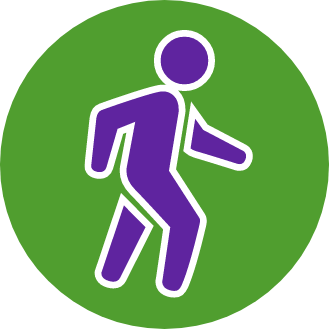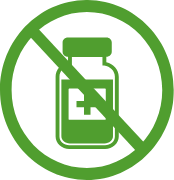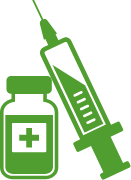COMET TRIAL
The safety profile of NEXVIAZYME was well established1
No patients in the NEXVIAZYME group reported a severe IAR and 1 (2%) patient reported a a serious AR during the PAP (up to week 49) in the COMET trial.1
Adverse reactions reported in ≥6% of patients treated with NEXVIAZYME at week 491
| ADVERSE REACTION |
NEXVIAZYME |
ALGLUCOSIDASE ALFA |
| Headache | 11 (22%) | 16 (33%) |
| Fatigue | 9 (18%) | 7 (14%) |
| Diarrhea | 6 (12%) | 8 (16%) |
| Nausea | 6 (12%) | 7 (14%) |
| Arthralgia | 5 (10%) | 8 (16%) |
| Dizziness | 5 (10%) | 4 (8%) |
| Myalgia | 5 (10%) | 7 (14%) |
| Pruritus | 4 (8%) | 4 (8%) |
| Vomiting | 4 (8%) | 3 (6%) |
| Dyspnea | 3 (6%) | 4 (8%) |
| Erythema | 3 (6%) | 3 (6%) |
| Paresthesia | 3 (6%) | 2 (4%) |
| Urticaria | 3 (6%) | 1 (2%) |
NEXVIAZYME IARs AND ARs IN THE COMET TRIAL DURING THE PAP (UP TO WEEK 49)1,*
IARs
25% (13/51) of patients receiving NEXVIAZYME
33% (16/49) of patients receiving alglucosidase alfa
Mild-to-moderate IARs reported in >1 patient receiving NEXVIAZYME were headache, diarrhea, pruritus, urticaria, and rash
SEVERE IARs
0 patients receiving NEXVIAZYME
4% (2/49) of patients receiving alglucosidase alfa
SERIOUS ARs
2% (1/51) of patients receiving NEXVIAZYME
6% (3/49) of patients receiving alglucosidase alfa
*The COMET trial was not designed to demonstrate a statistically significant difference in the incidence of ARs between NEXVIAZYME and alglucosidase alfa.
AR=adverse reaction; IAR=infusion-associated reaction.
During the ETP (up to week 145), no new safety concerns were observed in the NEXVIAZYME arm or the Switch arm.2


Switch and long-term efficacy data is available2
Walking and breathing ability was observed up to week 145 in patients receiving NEXVIAZYME, including those who switched from alglucosidase alfa at week 49.
Pooled safety data1
A long-term look at the NEX move

Up to 7 years1,3
- Pooled safety analysis was gathered for 141 patients with Pompe disease treated with NEXVIAZYME (118 adult and 23 pediatric), including patients who switched from alglucosidase alfa. Adverse reactions were similar across both adult and pediatric populations

Treatment discontinuation1
- 3% (4/141) of NEXVIAZYME-treated patients permanently discontinued treatment due to adverse reactions
- 3 of the 4 patients discontinued because of serious adverse reactions

Infusion-associated reactions1
- IARs reported in more than 1 patient included chest discomfort, cyanosis, decreased or increased blood pressure, diarrhea, dizziness, erythema, fatigue, feeling hot or cold, generalized edema, headache, hyperhidrosis, hypoxia, influenza-like illness, nausea, pain, pruritus, pyrexia, rash, respiratory distress, tachycardia, throat irritation, tongue edema, tremor, urticaria, and vomiting

Serious adverse reactions1
- In 2 or more NEXVIAZYME-treated patients, respiratory distress, chills, and pyrexia were reported

Most frequent adverse reactions1
- In >5% of patients in the pooled safety population, abdominal pain, arthralgia, chills, diarrhea, dizziness, dyspnea, erythema, fatigue, flushing, headache, hypertension, hypotension, myalgia, nausea, pruritus, pyrexia, rash, vomiting, and urticaria were reported
Immunogenicity and antidrug antibodies (ADA)1
ADA activity was monitored in NEXVIAZYME-treated patients for up to 8 years.
Incidence of anti-NEXVIAZYME antibodies in patients with Pompe disease1
Most adults and some children developed ADA following treatment with NEXVIAZYME. Most ADA were not neutralizing antibodies (NAbs).
In ERT-naive NEXVIAZYME-treated patients1,*
Seroconversion:
The median time to seroconversion was 8 weeks.
Incidence of IARs:
69% (9/13) in those with ADA peak titer ≥12,800
27% (12/44) in those with ADA titer <12,800
33% (1/3) in those who were ADA negative
One adult patient (with ADA peak titer 3200) developed anaphylaxis
In ERT-experienced patients who switched to NEXVIAZYME1
Adult patients who developed ADA had increased incidence of IARs and hypersensitivity reactions versus those ADA negative.
One pediatric patient (peak ADA titer 6,400) and 2 adult patients (ADA peak titers 800 and 12,800, respectively) developed anaphylaxis.
|
NEXVIAZYME1 |
||||
|
|
Treatment-Naive |
Treatment-Experienced Patients: |
||
|
|
Adults/Pediatrics |
Adults |
Pediatrics |
Pediatrics |
|
|
n (%) |
n (%) |
n (%) |
n (%) |
|
ADA at |
2 (3%) |
43 (74%) |
1 (17%) |
2 (13%) |
|
ADA after |
59 (95%) |
36 (62%) |
1 (17%) |
9 (56%) |
|
Neutralizing Antibody (NAb) |
||||
|
Both NAb |
14 (23%) |
5 (9%) |
0 |
0 |
|
Inhibition |
19 (31%) |
11 (19%) |
0 |
0 |
|
Inhibition |
26 (42%) |
20 (34%) |
0 |
2 (13%) |
There was no identified clinically significant effect of ADA on efficacy or pharmacokinetics.
A trend toward decreased pharmacodynamic response was observed in patients with ADA peak titer ≥12,800.
The observed incidence of anti-drug antibodies (ADA) is highly dependent on the sensitivity and specificity of the assay. Differences in assay methods preclude meaningful comparisons of the incidence of ADAs in the studies described above with the incidence of ADAs in other studies, including those of NEXVIAZYME or of other avalglucosidase alfa products.
*Mean 47 months, up to 8 years of treatment.
†Includes 2 pediatric patients.
‡Treatment naive: treated only with NEXVIAZYME.
§ERT-experienced: patients previously treated with alglucosidase alfa within a range of 0.9-9.9 years for adult patients and 0.6-11.8 years for pediatric patients before they received NEXVIAZYME.
|
WARNING: SEVERE HYPERSENSITIVITY REACTIONS, INFUSION-ASSOCIATED REACTIONS, and RISK OF ACUTE CARDIORESPIRATORY FAILURE IN SUSCEPTIBLE PATIENTS Hypersensitivity Reactions including Anaphylaxis Patients treated with NEXVIAZYME have experienced life-threatening hypersensitivity reactions, including anaphylaxis. Appropriate medical support measures, including cardiopulmonary resuscitation equipment, should be readily available during NEXVIAZYME administration. If a severe hypersensitivity reaction (e.g., anaphylaxis) occurs, NEXVIAZYME should be discontinued immediately and appropriate medical treatment should be initiated. In patients with severe hypersensitivity reaction, a desensitization procedure to NEXVIAZYME may be considered. Infusion-Associated Reactions (IARs) Patients treated with NEXVIAZYME have experienced severe IARs. If severe IARs occur, consider immediate discontinuation of NEXVIAZYME, initiation of appropriate medical treatment, and the benefits and risks of readministering NEXVIAZYME following severe IARs. Patients with an acute underlying illness at the time of NEXVIAZYME infusion may be at greater risk for IARs. Patients with advanced Pompe disease may have compromised cardiac and respiratory function, which may predispose them to a higher risk of severe complications from IARs. Risk of Acute Cardiorespiratory Failure in Susceptible Patients Patients susceptible to fluid volume overload, or those with acute underlying respiratory illness or compromised cardiac or respiratory function for whom fluid restriction is indicated may be at risk of serious exacerbation of their cardiac or respiratory status during NEXVIAZYME infusion. More frequent monitoring of vitals should be performed during NEXVIAZYME infusion. |
WARNINGS AND PRECAUTIONS
Hypersensitivity Reactions Including Anaphylaxis: See Boxed WARNING. Prior to NEXVIAZYME administration, consider pretreating with antihistamines, antipyretics, and/or corticosteroids. The risks and benefits of readministering NEXVIAZYME following severe hypersensitivity reaction (including anaphylaxis) should be considered. If a mild or moderate hypersensitivity reaction occurs, the infusion rate may be slowed or temporarily stopped.
Infusion-Associated Reactions: See Boxed WARNING. IARs may still occur in patients after receiving pretreatment. If mild or moderate IARs occur regardless of pretreatment, decreasing the infusion rate or temporarily stopping the infusion may ameliorate the symptoms.
Risk of Acute Cardiorespiratory Failure in Susceptible Patients: See Boxed WARNING.
ADVERSE REACTIONS
The most common adverse reactions (>5%) were headache, fatigue, diarrhea, nausea, arthralgia, dizziness, myalgia, pruritus, vomiting, dyspnea, erythema, paresthesia and urticaria.
INDICATION
NEXVIAZYME (avalglucosidase alfa-ngpt) is indicated for the treatment of patients 1 year of age and older with late-onset Pompe disease [lysosomal acid alpha-glucosidase (GAA) deficiency].
Please see full Prescribing Information for complete details, including Boxed WARNING.
References: 1. NEXVIAZYME (avalglucosidase alfa-ngpt) [prescribing information]. Genzyme Corporation, Cambridge, MA. 2. Straub S, Kishnani P, Diaz-Manera J, et al. Efficacy and safety of avalglucosidase alfa in participants with late-onset Pompe disease after 145 weeks of treatment during the COMET trial. Poster presented at: Muscular Dystrophy Association (MDA) Clinical & Scientific Conference; March 19–22, 2023; Dallas, TX. 3. Center for Drug Evaluation and Research. 761194Orig1s000 Integrated Review. April 23, 2020.
|
WARNING: SEVERE HYPERSENSITIVITY REACTIONS, INFUSION-ASSOCIATED REACTIONS, and RISK OF ACUTE CARDIORESPIRATORY FAILURE IN SUSCEPTIBLE PATIENTS Hypersensitivity Reactions including Anaphylaxis Patients treated with NEXVIAZYME have experienced life-threatening hypersensitivity reactions, including anaphylaxis. Appropriate medical support measures, including cardiopulmonary resuscitation equipment, should be readily available during NEXVIAZYME administration. If a severe hypersensitivity reaction (e.g., anaphylaxis) occurs, NEXVIAZYME should be discontinued immediately and appropriate medical treatment should be initiated. In patients with severe hypersensitivity reaction, a desensitization procedure to NEXVIAZYME may be considered. Infusion-Associated Reactions (IARs) Patients treated with NEXVIAZYME have experienced severe IARs. If severe IARs occur, consider immediate discontinuation of NEXVIAZYME, initiation of appropriate medical treatment, and the benefits and risks of readministering NEXVIAZYME following severe IARs. Patients with an acute underlying illness at the time of NEXVIAZYME infusion may be at greater risk for IARs. Patients with advanced Pompe disease may have compromised cardiac and respiratory function, which may predispose them to a higher risk of severe complications from IARs. Risk of Acute Cardiorespiratory Failure in Susceptible Patients Patients susceptible to fluid volume overload, or those with acute underlying respiratory illness or compromised cardiac or respiratory function for whom fluid restriction is indicated may be at risk of serious exacerbation of their cardiac or respiratory status during NEXVIAZYME infusion. More frequent monitoring of vitals should be performed during NEXVIAZYME infusion. |
WARNINGS AND PRECAUTIONS
Hypersensitivity Reactions Including Anaphylaxis: See Boxed WARNING. Prior to NEXVIAZYME administration, consider pretreating with antihistamines, antipyretics, and/or corticosteroids. The risks and benefits of readministering NEXVIAZYME following severe hypersensitivity reaction (including anaphylaxis) should be considered. If a mild or moderate hypersensitivity reaction occurs, the infusion rate may be slowed or temporarily stopped.
Infusion-Associated Reactions: See Boxed WARNING. IARs may still occur in patients after receiving pretreatment. If mild or moderate IARs occur regardless of pretreatment, decreasing the infusion rate or temporarily stopping the infusion may ameliorate the symptoms.
Risk of Acute Cardiorespiratory Failure in Susceptible Patients: See Boxed WARNING.
ADVERSE REACTIONS
The most common adverse reactions (>5%) were headache, fatigue, diarrhea, nausea, arthralgia, dizziness, myalgia, pruritus, vomiting, dyspnea, erythema, paresthesia and urticaria.
INDICATION
NEXVIAZYME (avalglucosidase alfa-ngpt) is indicated for the treatment of patients 1 year of age and older with late-onset Pompe disease [lysosomal acid alpha-glucosidase (GAA) deficiency].
Please see full Prescribing Information for complete details, including Boxed WARNING.
References: 1. NEXVIAZYME (avalglucosidase alfa-ngpt) [prescribing information]. Genzyme Corporation, Cambridge, MA. 2. Straub S, Kishnani P, Diaz-Manera J, et al. Efficacy and safety of avalglucosidase alfa in participants with late-onset Pompe disease after 145 weeks of treatment during the COMET trial. Poster presented at: Muscular Dystrophy Association (MDA) Clinical & Scientific Conference; March 19–22, 2023; Dallas, TX. 3. Center for Drug Evaluation and Research. 761194Orig1s000 Integrated Review. April 23, 2020.
